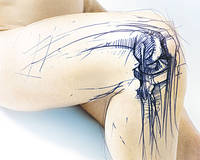Orthopedics
CONSERVATIVE ORTHOPEDICS AND SURGICAL ORTHOPEDICS
 Orthopedics and orthopedic surgery are important subdisciplines of medicine.
Orthopedics and orthopedic surgery are important subdisciplines of medicine.
They comprise the diagnosis, therapy, prevention and rehabilitation of diseases and injuries of the supporting and locomotor apparatus. Orthopedics are the medical discipline dealing with bones, muscles, tendons and joints and their degenerations and diseases.
The supporting and locomotor organs are the biggest organ system of the human body and can therefore be affected by many different diseases.
ENDOSCOPIC INSTRUMENTS AND DEVICES IN ORTHOPEDICS
Richard Wolf 's product range offers endoscopic instrumentation and devices specially developed for orthopedic operations. In particular in orthopedics, diagnostic and therapeutic possibilities are becoming ever more versatile and effective. With their growing experience users also wish to have extended therapy options and the new instrumentation required for such options.
In addition to innovative new developments our range of endoscopic instruments in orthopedics comprises over 800 products for human medicine. Richard Wolf produces and markets arthroscopic systems and implants for the treatment of all joints. This includes large joints such as hip, shoulder, elbow, and knee joints as well as hand, finger and ankle joints.
For almost every joint injury or connected soft tissue injury Richard Wolf supplies the optimum product. Joint disorders caused by sports injuries, joint wear or degenerative processes are a common disease of our time. Without the latest arthroscopic methods many operations on joints could not be carried out.
Comprehensive medical know-how is an integral part of our research and development. International cooperation and partnerships with leading enterprises such as the japanese implant manufacturer of bioresorbable products, Takiron, offer our customers competence and flexibility.
INJURIES OF THE CRUCIATE LIGAMENT AND MENISCAL LESIONS
Over the past decades the number of injuries of the capsule ligament apparatus of the knee joint has steadily increased. This is in part due to the intensive leisure time activities of large sections of the population. Ball sports and skiing are amongst such knee-joint-stressing activities. Acute injuries of the knee joint can be reliably diagnosed thanks to clinical diagnostics such as arthroscopy and magnetic resonnance tomography (MRI).
The anterior cruciate ligament is amongst the most frequently injured ligaments of the knee joint. Only in a few cases an isolated injury of the anterior cruciate ligament is found. Rather, in 3 out of 4 acute ACL ruptures, concomitant injuries are diagnosed, out of which 75% are meniscal lesions.
INTERFERENCE SCREW
A simple technical solution for direct fixation of the transplant in the femur and tibia using interference screws generates a stable fixation close to the insertion. The method is established all over the world. The interference screws compress the bone plug or ligament in the tibial or femural drill tunnel, thereby promoting fast bone growth. This allows fast functional aftercare, which again reduces swelling and pain.
ADVANTAGES OF BIORESORBABLE SCREWS
Fixing the transplant with metal screws is a widely used method. Implanted metal screws, however, may have a negative after effect, such as hypersensitivity to metals, stress concentrations on the bone, metal artefacts under radiological follow-up examinations. This pushed the development of bioresorbable interference screws. The Richard Wolf Bioact IF Osteotrans bioresorbable interference screws guarantee the same initial ancoring as metal screws. Over time, however, they dissolve slowly and are replaced by the patient's own bone tissue.